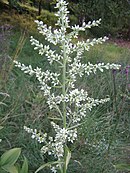Liliales
Alstroemeriaceae Campynemataceae Colchicaceae Corsiaceae Liliaceae Melanthiaceae Petermanniaceae Philesiaceae Ripogonaceae Smilacaceae Liliiflora Liliales is an order of monocotyledonous flowering plants in the Angiosperm Phylogeny Group and Angiosperm Phylogeny Web system, within the lilioid monocots.
Both the order Lililiales and the family Liliaceae have had a widely disputed history, with the circumscription varying greatly from one taxonomist to another.
Well known plants from the order include Lilium (lily), tulip, the North American wildflower Trillium, and greenbrier.
The larger families (with more than 100 species) are roughly confined to the Northern Hemisphere, or are distributed worldwide, centering on the north.
They also include woody shrubs, which have fleshy stems and underground storage or perennating organs, mainly bulbous geophytes, sometimes rhizomatous or cormous.
[7][8][9] The flowers are highly variable, ranging in size from the small green actinomorphic (radially symmetric) blooms of Smilax to the large showy ones found in Lilium, Tulipa and Calochortus (Liliaceae) and Lapageria (Philesiaceae).
[14] With 11 families, about 67 genera and about 1,558 species, Liliales is a relatively small angiosperm order, but a large group within the monocotyledons.
[9][15] The botanical authority for Liliales is given to Perleb (1826), who grouped eleven families (Asparageae, Pontederiaceae, Asphodeleae, Coronariae,[a] Colchicaceae, Dioscoreaceae, Hypoxideae, Amaryllideae, Haemodoraceae, Burmanniaceae, Irideae) into an order he called Liliaceae.
[17] A number of later taxonomists, such as Endlicher (1836) substitituted the term Coronarieae for this higher order, including six subordinate taxa.
[19] Although Bentham (1877) restored Coronariae as one of seven Series making up the monocotyledons,[20] it was replaced by Liliiflorae and then Liliales in subsequent publications (see Table for history).
[21] Subsequent authors, now adopting a phylogenetic (phyletic) or evolutionary approach over the natural method,[22] did not follow Bentham's nomenclature.
Cronquist (1981) placed the order Liliales as one of two in subclass Liliidae, one of five in the class Liliopsida (monocotyledons) of division Magnoliophyta (angiosperms).
Takhtajan (1997) had a more complex system of higher taxonomic ranks, placing Liliales as one of 15 orders within superorder Lilianae, one of four within subclass Liliidae.
[33] The development of molecular phylogenetic methods for determining taxonomic circumscription and phylogeny led to considerable revision of angiosperm classification,[34] and establishment of Liliales as a monophyletic group.
[34] The new classification was formalised with the creation of the Angiosperm Phylogeny Group (APG) system (1998–2016),[37][38] based on monophyletic clades, which continued the use of Liliales as the name for the taxon.
[39] The Angiosperm Phylogeny Group APG system (1998) established a structure of monocot classification with ten orders.
[37] Notable was the separation of asparagids, as suggested by Dahlgren,[10] into Asparagales, with other taxa placed in Dioscoreales, resulting in a much reduced order.
In the cladogram the numbers indicate crown group (most recent common ancestor of the sampled species of the clade of interest) divergence times in mya (million years ago).
They are found in montane forests in South America (one genus) and from southern China to northern Australia in areas with high rainfall, and among dense leaf litter.
Their distribution is temperate and boreal Northern hemisphere, in the Americas extending south to the Andes and in Asia to the Himalayas and Taiwan.
The family name is derived from the Greek words melas (black) and anthos (flower) in reference to the dark colour of the petals.
[48][49] The Colchicaceae (Naked-ladies or Colchicum family) are perennial erect and climbing plants with underground corms, tubers and rhizomes.
Although the alkaloids, which characterise them, they contain are toxic to animals and humans, Colchicine has usage medicinally and in botanical laboratories.
[48][49][9] The Alstroemeriaceae (Inca-lily family) are erect or creeping perennial (rarely annual) herbaceous plants with occasional shrubby vines, some of which have evergreen stems.
Two species are widely used for food in S America, Alstroemeria ligtu is used for a flour (Chuño) that is extracted from its roots, while the tubers of Bomarea edulis are directly consumed.
They are woody evergreen shrubs and vines arising from a horizontal rhizome, swollen at its base to form a tuber.
Smilacaceae are pantropical with extension into temperate zones north (N America, Mediterranean, Russian Far East) and south (Eastern Australia).
They are perennial herbaceous plants, growing from bulbs or corms (rarely creeping rhizomes), with actinomorphic hypogynous flowers that are often coloured and patterned.
They are predominantly northern temperate in distribution, with extension to subtropical areas of N Africa, India, China and Luzon, but are absent from the southern hemisphere.
[9] Liliales form important sources of food and pharmaceuticals as well as playing a significant role in horticulture and floriculture as ornamental plants.










